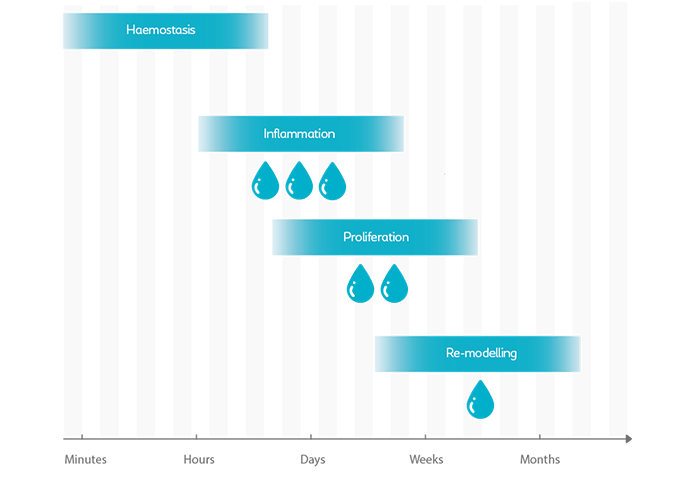Get full access with a free account
Benefits of the Coloplast® Professional Educational platform
- Get full access to all educational content, events and resources
- Track your progress
- Share content with your collegues
- Share supporting material with your patient
What is exudate pooling and why does it occur?
The gap is the space between the wound bed and the dressing. It’s also called the ‘dead space’. However, the space between the wound bed and the dressing is far from ‘dead’.
Let’s see why that is.
All wounds have unique, irregular topographies, or shapes. Some wounds have steep angles between the edge of the wound and the wound bed. This can create cavities where fluid – or exudate – can accumulate. To find out how this might affect wound healing, we need to take a closer look at exudate.
What is exudate?
Perhaps you know it as ‘ooze’, ‘wound fluid’, ‘wound drainage’, ‘pus’ or ‘secretion’. All of these names refer to the fluid a wound creates when it’s healing. In this section, we use the term, exudate.5
All wounds have exudate. This fluid is usually clear. It has a pale amber colour and a watery consistency. Wound exudate plays an essential role in the healing process.
How exudate impacts wound healing
Exudate facilitates the flow of vital healing factors and cells across the wound bed. It:
- promotes cell growth;
- provides nutrients for cell metabolism; and
- helps to destroy dead or damaged tissue (also known as autolysis).7
Exudate also helps keep the wound environment moist, which makes the wound heal faster. In fact, studies show that moist wounds heal two to three times faster than dry wounds.7
Why exudate can stop wound healing
While exudate is essential to the healing process, it can also stop a wound from healing. This can happen if:
- the wound has the wrong amount of exudate (either too much, or too little);
- the exudate is the wrong composition; or
- the exudate is in the wrong place.8, 7
As a wound begins to heal, the amount of exudate it produces usually decreases. However, many chronic wounds can get stuck in the inflammatory healing stage where harmful bacteria might develop.
In such cases, exudate can:
- obstruct healing;
- slow down or prevent cell growth;
- interfere with growth factor availability; and
- contain elevated levels of inflammatory mediators; e.g. platelets, neutrophils, monocytes /macrophages and mast cells.7
This brings us back to ‘the gap’, and why managing the gap is so important for wound healing.
As a wound heals, the level of exudate it produces will decrease. However, if a wound gets stuck in the inflammatory stage of healing, it will continue to produce moderate to high levels of exudate.

Why managing the gap is critical to prevent exudate pooling
When exudate accumulates in the gap between the wound bed and the dressing, it’s called exudate pooling. This is particularly a challenge in wounds with irregular topographies, cavities or pockets.9
Exudate can begin to pool when:
- the dressing doesn’t absorb the exudate properly;
- the volume of fluid is greater than the dressing can absorb; or
- when the dressing does not conform closely enough to the wound bed1
When pools of exudate form, it allows for bacteria to grow in the wound - this inceases the risk of infection.3, 4, 10 And if the exudate leaks onto the wound edge and surrounding, or periwound, skin, the skin can become macerated. All of this delays the healing process.11, 12, 13, 14
